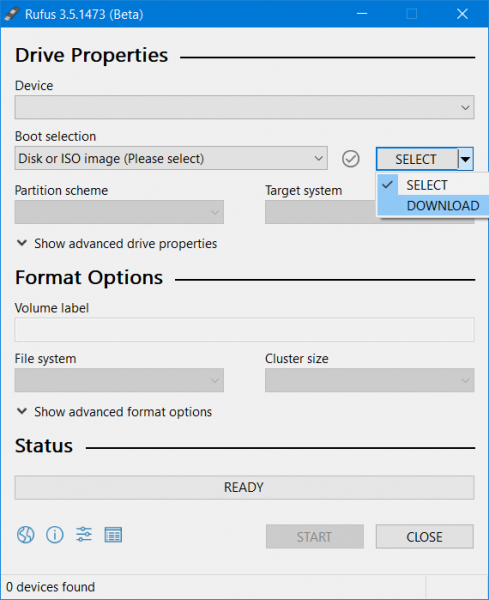

- #Download rufus for windows 10 how to
- #Download rufus for windows 10 software download
- #Download rufus for windows 10 .exe
- #Download rufus for windows 10 Pc
- #Download rufus for windows 10 iso

#Download rufus for windows 10 how to
In case you want to read our step by step tutorial about how to do a clean install of Windows 10 next by using Bootable USB created by following above steps, click here. After the download is complete and the Bootable media is created, select Finish.Connect your USB flash drive, click/tap on the Refresh drive list link, select the USB flash drive, and click/tap on Next.We recommend using a blank USB or blank DVD, because any content on it will be deleted. A blank USB or DVD (and DVD burner) with at least 4 GB of space if you want to create media.Now choose USB Flash Drive option in the next screen and click on next.Check the screenshot below that shows how one can choose these options. Choose the language, edition, and architecture (64-bit or 32-bit) for Windows 10.Select Create installation media for another PC.
#Download rufus for windows 10 Pc
(You need to be an Administrator on the PC to run it.) Run the tool, if you didn’t already select Run above.When you’re asked, select Run (or choose to Save the tool if you don’t want to run it now). If your PC is a 64-bit operating system, select Download tool now (64-bit version).
#Download rufus for windows 10 software download
If your PC is a 32-bit operating system, on the Software download page, select Download tool now (32-bit version). There are two versions of the tool, one for a “32-bit operating system” and one for a “64-bit operating system.” To find out which you have, go to Start, type Control panel, select System and security, and then, under System, look at the value for System type. So, as you can understand it works only for the official Windows 10 general release build.įind the media creation tool on the Software download page. It is quite easy to use and if you check our tutorial on updating to Windows 10 and downloading official ISOs, we have also shared steps to create Bootable USB drive using Media Creation Tool. Using official Media Creation Tool (Method 2):

Cluster size: Default value (4096 bytes).Partition scheme and target system type: MBR partition scheme for BIOS or UEFI-CSM under.
#Download rufus for windows 10 iso
Click/tap on the Disk icon to navigate to and select your 32-bit or 64-bit Windows 10 ISO file.Device option: Select the USB flash drive you want to format.
#Download rufus for windows 10 .exe
exe file, and click/tap on Yes if prompted by UAC.Ħ) Set Rufus using the settings below which are valid for both 32-Bit and 64-Bit Windows 10 ISO files. Rufus is an easy-to-use and configurable tool which quickly creates bootable USB drives from ISO images.5) Run the Rufus. We created a bootable USB version of the Windows 8 Professional image, for instance, and found the program was around 25% faster than another popular boot drive creator, UNetbootin. And the program even includes some advanced format options which may help your drive be recognised on older PCs, although normally these shouldn't be necessary.Īnd if this is a task you need to carry out often, then you'll be pleased to hear that Rufus is reasonably speedy. Double-click the executable to launch the tool. Under the Download section, click the link to download the latest version. There's now support for both UEFI and GPT boots. To use Rufus to download the Windows 10 ISO file and create a bootable media, connect a USB flash drive with 8GB of space, and then use these steps: Open Rufus website. If you need more control, though, you're able to configure how the USB drive will be formatted (file system, cluster size and so on). Getting started could be as simple as browsing to your ISO image and clicking the "Start" button: the program will then walk you through everything else it needs to know. It'll automatically detect your USB drive, for instance, so you may not have to select that. Rufus doesn't require any installation, and is generally very straightforward to set up. USB keys are also easier to carry around, less likely to be damaged, and faster, which may be important if you need to use the disc often. This won't help you much if your target system doesn't have an optical drive, though. Of course if you have an ISO image then you could simply burn this to a CD or DVD. Rufus is a simple utility which makes it easy to build bootable USB drives from ISO images.


 0 kommentar(er)
0 kommentar(er)
